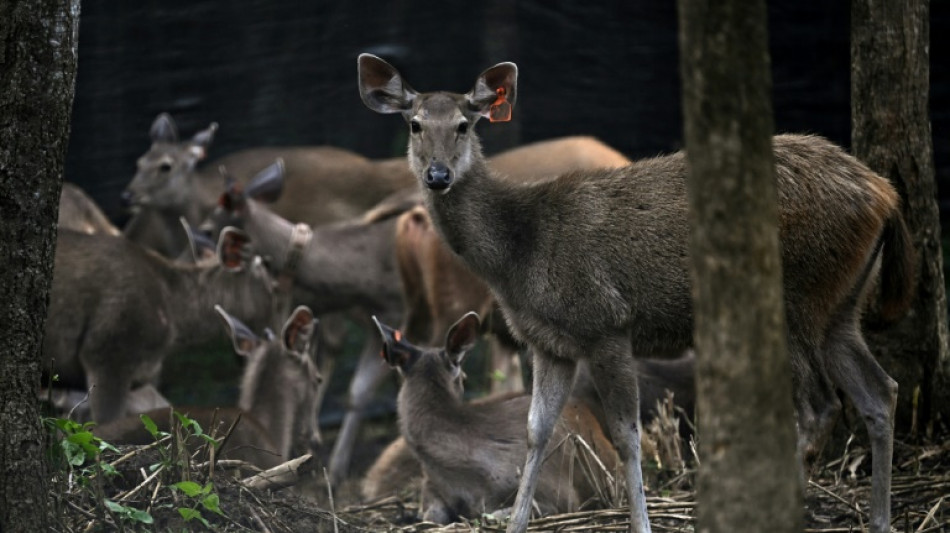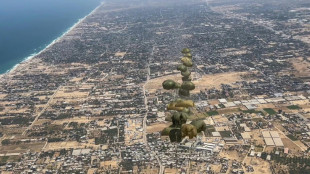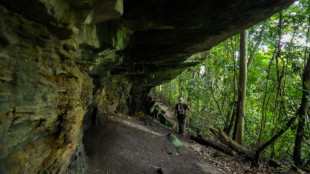
-
 UK-France migrant returns deal takes effect
UK-France migrant returns deal takes effect
-
Japan sets record temperature of 41.8C

-
 Banned Russian media sites 'still accessible' across EU: report
Banned Russian media sites 'still accessible' across EU: report
-
Bangladesh's Yunus calls for reform on revolution anniversary

-
 Russian strikes kill three in east Ukraine
Russian strikes kill three in east Ukraine
-
Israel poised to order new Gaza war plan

-
 Dutch are first to buy US arms for Ukraine under NATO scheme
Dutch are first to buy US arms for Ukraine under NATO scheme
-
Oil giant BP returns to profit in second quarter

-
 Saudi Aramco profit drops for 10th straight quarter
Saudi Aramco profit drops for 10th straight quarter
-
Beijing lifts rain alert after tens of thousands evacuated

-
 Record heatwave blasts northern Vietnam
Record heatwave blasts northern Vietnam
-
Saudi Aramco profit drops 22 percent on lower prices

-
 Japan sets new record high temperature of 41.8C
Japan sets new record high temperature of 41.8C
-
Gabon forest cave reveals clues about prehistoric central Africa

-
 Death of a delta: Pakistan's Indus sinks and shrinks
Death of a delta: Pakistan's Indus sinks and shrinks
-
Gen Z shift, high costs force UK nightclubs to reinvent

-
 Water shortages spell trouble on Turkey's tourist coast
Water shortages spell trouble on Turkey's tourist coast
-
Dutch windmill village churned by overtourism debate

-
 Malaysia tycoon pleads guilty in Singapore to abetting obstruction of justice
Malaysia tycoon pleads guilty in Singapore to abetting obstruction of justice
-
England face searching Ashes questions after India series thriller

-
 Zverev to meet Khachanov in ATP Toronto semi-finals
Zverev to meet Khachanov in ATP Toronto semi-finals
-
Swiss 'Mountain Tinder' sparks high-altitude attraction

-
 Hong Kong hit by flooding after flurry of rainstorm warnings
Hong Kong hit by flooding after flurry of rainstorm warnings
-
Asian markets track Wall St rally on Fed rate cut bets

-
 Gaza war deepens Israel's divides
Gaza war deepens Israel's divides
-
Beijing lifts rain alert after evacuating over 80,000

-
 Decision time as plastic pollution treaty talks begin
Decision time as plastic pollution treaty talks begin
-
Zverev ignores fan distraction to advance to ATP Toronto semis

-
 Remains of 32 people found in Mexico's Guanajuato state
Remains of 32 people found in Mexico's Guanajuato state
-
Trump tariffs don't spare his fans in EU

-
 Brazil judge puts ex-president Bolsonaro under house arrest
Brazil judge puts ex-president Bolsonaro under house arrest
-
With six months to go, Winter Games organisers say they'll be ready

-
 Rybakina to face teen Mboko in WTA Canadian Open semis
Rybakina to face teen Mboko in WTA Canadian Open semis
-
Australia to buy 11 advanced warships from Japan

-
 Five years after Beirut port blast, Lebanese demand justice
Five years after Beirut port blast, Lebanese demand justice
-
Stella Rimington, first woman to lead UK's MI5 dies at 90

-
 Trump admin to reinstall Confederate statue toppled by protesters
Trump admin to reinstall Confederate statue toppled by protesters
-
Will DEA Cole Dismantle Marijuana Research Blockade - MMJ Biopharma Will Be His First Test Case

-
 BioNxt Solutions Reports Pending Patent Grants in Europe and Eurasia, Strengthening IP Protection for Proprietary Sublingual Cladribine-Based MS Treatment
BioNxt Solutions Reports Pending Patent Grants in Europe and Eurasia, Strengthening IP Protection for Proprietary Sublingual Cladribine-Based MS Treatment
-
Star Copper Announces Plans for Fully Funded Fall 2025 Phase 2 Drill Campaign in Golden Triangle of BC

-
 Rybakina advances to WTA Canadian Open semis
Rybakina advances to WTA Canadian Open semis
-
Brazilian judge places ex-president Bolsonaro under house arrest

-
 Brazil judge places ex-president Bolsonaro under house arrest
Brazil judge places ex-president Bolsonaro under house arrest
-
NGOs caught between juntas and jihadists in turbulent Sahel

-
 NBA Spurs agree to four-year extension with Fox: reports
NBA Spurs agree to four-year extension with Fox: reports
-
Stocks mostly rebound on US interest rate cut bets

-
 Boeing defense workers launch strike over contract dispute
Boeing defense workers launch strike over contract dispute
-
Grand Canyon fire rages, one month on

-
 Djokovic withdraws from ATP Cincinnati Masters
Djokovic withdraws from ATP Cincinnati Masters
-
Brazil's Paixao promises 'big things' at Marseille unveiling

| SCU | 0% | 12.72 | $ | |
| BCC | -0.77% | 82.71 | $ | |
| CMSD | 1.18% | 23.63 | $ | |
| BCE | -1.12% | 23.31 | $ | |
| GSK | 0.32% | 37.68 | $ | |
| RBGPF | 0% | 74.94 | $ | |
| CMSC | 0.87% | 23.07 | $ | |
| RIO | 0.58% | 60 | $ | |
| JRI | 0.76% | 13.2 | $ | |
| AZN | 0.86% | 74.59 | $ | |
| SCS | 38.6% | 16.58 | $ | |
| NGG | 1.14% | 72.65 | $ | |
| RYCEF | 2.14% | 14.5 | $ | |
| RELX | 0.73% | 51.97 | $ | |
| BTI | 2.16% | 55.55 | $ | |
| VOD | 0.72% | 11.04 | $ | |
| BP | 2.28% | 32.49 | $ |

Thailand credits prey releases for 'extraordinary' tiger recovery
In the thick, steamy forests of western Thailand, 20 skittish sambar deer dart from an enclosure into the undergrowth -- unaware they may find themselves in the jaws of one of the habitat's 200 or so endangered tigers.
The release is part of a project run by the government and conservation group WWF to provide tigers with prey to hunt and eat, which has helped the big cat make a remarkable recovery in Thailand.
The wild tiger population in Thailand's Western Forest Complex, near the border with Myanmar, has increased almost fivefold in the last 15 years from about 40 in 2007 to between 179 and 223 last year, according to the kingdom's Department of National Parks (DNP).
It is an uptick that WWF's Tigers Alive initiative leader Stuart Chapman calls "extraordinary", especially as no other country in Southeast Asia has seen tiger numbers pick up at all.
The DNP and the WWF have been breeding sambar, which are native to Thailand but classed as vulnerable, and releasing them as prey.
Now in its fifth year, the prey release is a "very good activity," says the DNP's Chaiya Danpho, as it addresses the ecosystem's lack of large ungulates for tigers to eat.
Worrapan Phumanee, a research manager for WWF Thailand, says that deer were previously scarce in the area, impacting the tiger population.
But "since starting the project, we've seen tigers become regular residents here and successfully breed," he says.
Cambodia, Laos and Vietnam have all lost their native populations of Indochinese tigers, while Myanmar is thought to have just 23 left in the wild, in large part due to poaching and wildlife trafficking.
Over the past century numbers worldwide have fallen from about 100,000 individuals to an estimated 5,500, according to the IUCN, which classifies tigers as endangered due to habitat loss and overhunting of the species and their natural prey.
But major tiger recoveries have been recorded in India and Nepal, where in recent years numbers of Bengal tigers have grown to 3,600 and 355 respectively thanks to conservation measures.
- 'Incredibly successful' -
In a forest clearing in Khlong Lan National Park, DNP staff open the gate of the sambar deer enclosure where 10 males and 10 females have been grazing.
The deer watch cautiously as one brave individual darts out, before the rest follow at speed and disappear into the trees.
Worrapan says prey release programmes -- now also happening in Cambodia and Malaysia -- are part of wider restoration efforts to "rebuild ecosystems" in Southeast Asia, where they have been adapted for local purposes from similar initiatives that have existed for years in Africa.
The breeding and releases also aim to solve the problem of the sambar deer's own population decline due to hunting, says Worrapan.
"The purpose of releasing deer is not solely to serve as tiger prey but also to restore the deer population," he says, adding that GPS collar-monitoring has allowed researchers to track their lives after release.
He says despite having only known captivity, the deer show a strong ability to adapt to outside threats.
"(They) don't simply wait passively. They try to evade predators and choose safe areas to thrive."
Chaiya says only a small number of the released deer end up as predator dinner, with most going on to reproduce.
The sambar deer and their offspring "play a role in the food chain within the ecosystem, serving as prey for predators," he says.
P.M.Smith--AMWN


